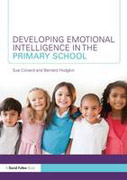
Developing emotional intelligence in the primary school
Colverd, Sue
Hodgkin, Bernard
Do you want to promote sociability and positive behaviour in your classroom? Is having an 'emotionally intelligent classroom' one of your teaching goals? Are you looking for ways to teach the curriculum more 'creatively'? Developing Emotional Intelligence in the Primary School is an essential text for supporting children's emotional preparation for learning in the long term, fostering the development both of self belief and permanent and crucial resilience. This book allows teachers to review their practice and approach to teaching and to re-assess how they view their pupils. Using practical drama frames that the teacher can develop for themselves, it gives a background and framework to buildemotional intelligence in a child and generate a culture of openness to learning in the classroom. Areas covered include: Self-esteem, emotional and socialintelligence; Independence and self-reliance; Creating an emotionally intelligent learning environment; Emotional literacy based around core curriculum areas including literacy and history; Conflict resolution and anti-bullying strategies; Building emotonal resilience in vulnerable children; Using and integrating positional drama for Emotional Intelligence. With a number of practical techniques and activities to be implemented in the classroom, this introduction to emotional intelligence will be of great interest to all primary school teachers looking to further understanding of pupils social and emotional development through learning. INDICE: Foreword How to use this book 1. Priorities in Practice (The whole child) Positive attachment Secure self identity Emotional intelligence Social intelligence Self esteem Learning styles 2. The Great Thinkers in Practice How does what you do in the classroom relate to the big thinkers? Interventions-- and practical application (Maslow -- Bowlby -- Goleman - Gardner) 3. Good teaching -- Good Behaviour? What is the connection between good teaching and good behaviour? What happens specifically in experiential drama approaches to allow pupils the freedom to "behave?" 4. Building Resilience Safety and security Developing self concept Developing self advocacy Teaching self reliance Working with Vulnerable Children Shaping work to avoid trauma 5. The Emotionally Intelligent classroom (The whole teacher) How do you create an environment for learning and good behaviour? The emotionally intelligent teacher -- limitations and potential Teachers approach to emotional intelligence Teachers approach to behavioural issues Model for assessing teaching The emotionally intelligentClassroom! 6. Using and integrating Positional Drama -- Placing the child at the centre of learning Use of Drama for Emotional and Social Intelligence Experiencing Positional Drama -- The Model Explained Taking Positions Points of View Playing safe Intention and Reflection 7. Positional Drama Models Models foremotional and social intelligence Warm -- ups Issue based work Literacy History Geography Science PSHE - conflict resolution/bullying Working with small groups Working in large groups Positional Drama Template Planning 8. PositioningOutcomes Can the pupil's creative engagement be researched, explained and utilised in teaching and Leaning at all ages? 9. Suggestions on Future Work
- ISBN: 978-0-415-56946-0
- Editorial: Routledge
- Encuadernacion: Rústica
- Páginas: 176
- Fecha Publicación: 01/02/2011
- Nº Volúmenes: 1
- Idioma: Inglés
